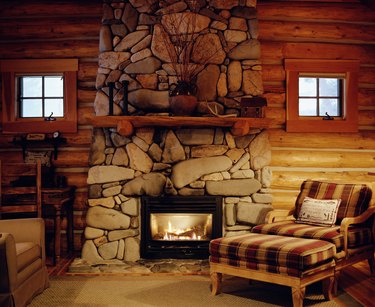
All building materials have their strengths and weaknesses. Wood is durable, plentiful, and beautiful, but it doesn't provide as much insulation as other materials. One of the disadvantages of log homes is that they tend to be drafty if they're not well insulated. Wood has a lower R-value than some building materials, which means homes constructed with a lot of wood may need a good deal of added insulation in order to be warm and energy efficient during cold weather.
What Does R-Value Measure?
Video of the Day
The R-value of a given building material describes its ability to resist heat. The higher a material's R-value, the better it is as an insulator. A material's specific R-value describes the insulation value of 1 inch of thickness.
Video of the Day
There's a little bit of math involved with calculating how well insulated your home is. As an example, say your exterior wall is made from a 4-inch-thick layer of a material that has an R-value of 1.5. The wall itself has a total R-value of 6.
Fiberglass has a high R-value, which is why it's commonly used as insulation. Say you insulate your walls using 5 inches of fiberglass insulation with an R-value of 3. That's an added R-value of 15, bringing the total R-value of your wall to 21. This total number is what's important because it tells you whether your home has enough insulation to be energy efficient.
The R-Value of Wood
The insulation value of wood varies depending on what type the wood is and how it has been treated. The R-value of softwoods ranges from 1.41 per inch for most softwoods to 0.71 for hardwoods. So, if you have an exterior wall made of 4-inch-thick wood, it might have an R-value somewhere in the range of 3 to 6.
What R-Value Should My Home Have?
Naturally, insulation is especially important for people living in cold areas. If your home is built with materials that have low R-values, you'll spend too much money on heat because a lot of it will escape. How much insulation you need depends on where you live, and it depends on what part of the house you're talking about.
Energy Star created a table dividing the United States into different zones with different R-value recommendations based on zone. For example, someone living in Florida should add enough insulation to their attic to reach an R-value between 30 and 49, while an attic in northern Minnesota should have an R-value between 49 and 60. Interior walls, of course, need much less insulation.
Practically speaking, homeowners may not be able to accurately calculate the specific R-value of various parts of their home. Pointing an infrared thermometer at various parts of your walls may give you some idea of where your home's cold zones are located. And you may be able to approximate the R-value of your attic by examining the current insulation. Bottom line? If your home feels drafty and/or you think you're paying unusually high energy bills, improving your home's R-value is as simple as installing additional insulation.